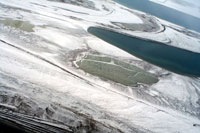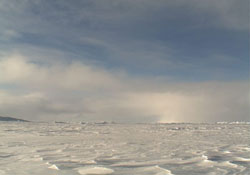Ice-free North Pole a distinct possibility this summer, say scientists
28 Jun 2008
 Santa Claus may soon be without a snow-capped residence, if leading climate scientists are to be believed. There is a distinct possibility that the Earth's rooftop at the North Pole could be free of sea ice this summer, for the first time in recorded history.
Santa Claus may soon be without a snow-capped residence, if leading climate scientists are to be believed. There is a distinct possibility that the Earth's rooftop at the North Pole could be free of sea ice this summer, for the first time in recorded history.
The Arctic's thick, resilient multiyear sea ice (frozen sea surface), which usually accumulates and lasts through the annual melting season, has started to give way to thinner, vulnerable first-year ice.
Satellite data gathered by the University of Colorado's National Snow and Ice Data Center showed that young sea ice, which is no more than about 60 inches deep and much more susceptible to melting away, now makes up only 72 per cent of the Arctic ice sheet. Using that estimate, scientists at the center see a 50 per cent chance that ice at the highest point in the Arctic will melt by the summer's end.
According to Mark Serreze, a senior researcher at the institution, the weather and ocean conditions in the next couple of weeks will determine how much of the sea ice will melt, and early signs are not encouraging. Already, figures from the National Snow and Ice Data Center show sea ice in the Arctic as a whole at about the same level now as it was at its low point last year in late June and early July.
The Colorado data seems to be supported by recent observations made by NASA. Preliminary February and March data from a NASA satellite shows that the circle of ice surrounding the North Pole is "considerably thinner" than scientists have seen during the five years the satellite has been taking pictures, NASA ice scientist Jay Zwally said yesterday. He estimates the chances of an ice-free North Pole as slightly less than 50-50.
Although different experts predict different timelines for ice to vanish from the North Pole in summer, all agree that ''it's just a matter of time.'' This is quite in contrast to the established view earlier when climate prediction models estimated it would take at least another 40 or 50 years before such a scenario is likely to occur.
 Increased rates of Arctic melt have altered the region in unprecedented ways. Arctic sea ice dwindled to a record low in September, clearing a route through the fabled Northwest Passage that runs from Greenland to Alaska. Opening of the path has provided ships a shorter, more direct route between Asia and Europe.
Increased rates of Arctic melt have altered the region in unprecedented ways. Arctic sea ice dwindled to a record low in September, clearing a route through the fabled Northwest Passage that runs from Greenland to Alaska. Opening of the path has provided ships a shorter, more direct route between Asia and Europe.
The disappearance of Arctic sea ice may mean an even hotter planet, since the region's ice pack helps cool the earth by bouncing the sun's rays back into outer space. This reflective property, known as albedo, also prevents the rays from reaching the ocean, where heat is absorbed.
Less sea ice means more dark open water to absorb the heat, which melts the sea ice even further.







.webp)














